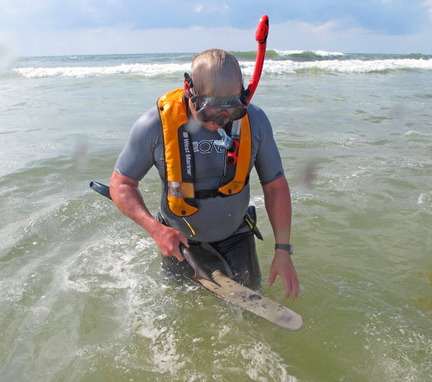
(Press-Register/Ben Raines)Todd Farrar, a BP contractor with the Shoreline Cleanup Assessment Team working its way along the Gulf Coast, examines a layer of oil buried a few inches below the seafloor at the Bon Secour National Wildlife Refuge. He estimated the sample contained about 15 percent oil, with the rest composed of sand and seashells.
http://blog.al.com/live/2010/09/oil_lingering_in_waters_off_al.html
Published: Thursday, September 23, 2010, 5:00 AM Updated: Thursday, September 23, 2010, 4:01 PM
Ben Raines, Press-Register
A good deal of oil remains in the shallow waters closest to the beaches in Mississippi, Alabama and Florida, according to a federal team using shovels and snorkeling gear to survey the coastline for submerged oil.
The team found tarballs washing ashore with every wave Wednesday morning in the Bon Secour National Wildlife Refuge. And just off the beach, in about 3 feet of water, the team found bands of oil buried under 4 or 5 inches of clean sand.
That’s proving to be a common problem, said Todd Farrar, who works for Polaris Applied Sciences, a company hired by BP to do the shoreline assessments with federal officials.
The Shoreline Cleanup Assessment Team, working its way along the Alabama coast this week, also included Aaron Boutin from the U.S. Coast Guard and Stephanie Hill from the National Oceanic and Atmospheric Administration.
The buried oil was broken into small pieces, some as small as BBs, others the size of marbles. Farrar said they were finding similar patches of oil scattered along the Gulf coast, primarily in the areas that saw the most oil come ashore.
The team works from the shoreline out to about 180 feet offshore, unless the water gets deeper than 10 feet.
“We’re basically digging potholes approximately 18 inches deep,” Farrar said. “We do transects in the areas that were hit harder with oil. We’re finding plenty of it.”
For oil close to the beach, the fix is simple: dig it out with heavy equipment sitting on shore.
Farther out, oil removal is more complicated. Farrar said most of it would be vacuumed up with heavy-duty pumps or dug out by track hoes on barges.
“For the greater depths, we haven’t worked out a method yet for doing the assessment,” Farrar said. “If they find oil at those greater depths, we might have to get more inventive about how to clean it up.”
Lauren Jorgensen, with the Coast Guard, said the so-called SCAT survey was the first step in the cleanup process.
“The SCAT teams go out and find evidence of oil underwater. They record the precise location where they find it and then recommend a cleanup method,” Jorgensen said. “Then we resurvey to make sure the cleanup was effective. We’re definitely trying to ensure that the oil is cleaned up.”
Farrar said the oil close to the shore tended to become buried in the layer of loose sand that gets moved around by waves.
Beneath that 5- or 6-inch layer, he said, the sand becomes more compact and resistant to wave action, meaning the oil doesn’t get any deeper.
In the potholes he dug Wednesday morning, Farrar reported that from 10 to 25 percent of the material in his shovel was oil, with the rest composed of sand and seashells. In some areas, the team has documented large mats of tar.
“The tar mats vary greatly. The biggest mat we found was about (150 feet by 210 feet). That was in Pensacola Bay. Some of them are much smaller,” Farrar said. “Usually, they are an inch to an inch-and-a-half thick, though we’ve seen 2 or 3 inches in different spots.”
In Pensacola, more than 3,000 pounds of an oil-sand mix was dredged up in a single day in some areas where Farrar’s team documented oil, according to BP officials.
Back in late June and early July, a large amount of oil was scooped from the Bon Secour beach Farrar snorkeled Wednesday.
Tarballs were still spread liberally around the wildlife refuge’s beaches Wednesday, from the water’s edge up to the first line of sand dunes.
While there was less oil on the sand than was present in July, tarballs remained as easy to find as seashells.
Special thanks to Richard Charter